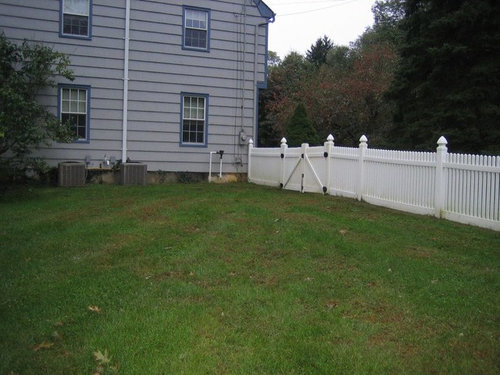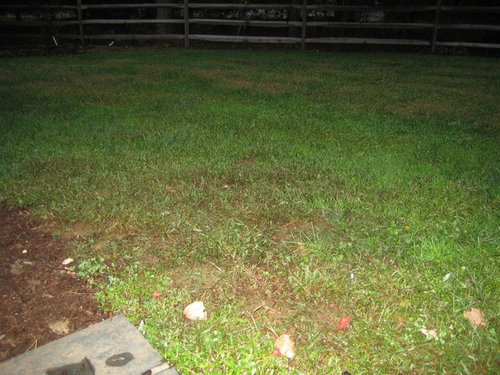Hello all--
I am contemplating renovation of my backyard lawn. It is fairly large, perhaps 5000 sq.ft. The area is fenced in because it is used by my dog, a 25 pound spaniel. I have been undertaking a lot of garden renovations this summer, and I have just started to upgrade this area. I have started planting shrubs and small trees but I will be doing a lot more of that next spring. I am also still working on improving the little woodland back there, and I still need to bring in a tree guy to remove deadwood and thin out overcrowded trees. So there may still be some equipment coming and going. I would like to complete that work before I begin on the lawn. Given that it is already October, I am probably looking to renovate next spring or even fall.
The current lawn, if you can call it that, has a myriad of problems, including compacting, drainage issues,terrible soil/thin topsoil, and uneven terrain. There is compaction because our lawn guy mowed it over and over again, even when it was soaking wet. The soil is bad because, when we built the screened porch which overlooks the yard, the contractor had a lot of sand left over which he just sort of dumped randomly. The soil wasn't very good even before that. As a result of all these issues, I have weeds, weeds, and more weeds. Between the house and the back fence row, there is essentially no grass. (The larger side area is somewhat better.) I have taken a good look at what is out there, and the main culprits seem to be smartweed, creeping Charlie, crabgrass, and Bermuda grass. In a few places there is moss.
As if this wasn't enough, the dog complicates everything! She's not a very big dog and it is a large area, so I think that her urine is not a huge problem, in general. That said, the area right near the bottom of the stairs gets used the most, and it also gets the most foot traffic, so it is very compacted and mostly bare dirt at this point. The larger problem is that we cannot really deny her access to the backyard for months on end. Even a few weeks would be challenging. I do not want to use chemicals, for obvious reasons. (Organic sprays such as concentrated vinegar or plant-based sprays would be okay.)
So, where do I start? I have been obsessing over this for weeks now, but I can't quite decide on an approach. Even though the bulk of the renovation will be next season, I would like to make my mind up in case there is preparation I could/should be doing over the winter. For instance, I could possibly smother the weeds over the winter using landscape fabric or newspaper and mulch. The way I see it, I really do need to wipe out everything that is there. The area then needs to be graded, topsoil and organic matter need to be added, and new seed or sod has to be installed. Ideally, what I would like to do is seed with the "No Mow" mixture from Prairie Nursery, which only needs cutting once or twice a season. Then I would no longer need a lawn guy to mow back there and I could avoid a repetition of the current problems. However, if I seed I will need to keep Amber out of the yard for several weeks. This would be less of a problem if I put down sod, but then I would have to get their "shade mix" which might not permit me the infrequent mowing schedule I would prefer.
I know there are arguments against rototilling, specifically bringing up more weed seeds and ending up with hills and valleys from the uneven cultivation. But would it will be possible to grade and add organic material without tilling? And speaking of organic matter, what can I use that will be affordable? This is a fairly large area and there is no way I can make enough compost for this purpose. Buying it in bulk is expensive. And I am not entirely trusting of topsoil that you can buy, either. It might be not much better than what I have.
I'm sorry to be writing a book here, but Ive been overthinking this. I really would appreciate any advice, though, on how to proceed. I've attached some photos of the area.
{{gwi:1105932}}



















Kimmsr
LizOriginal Author
Related Professionals
Parole Landscape Architects & Landscape Designers · Concord Landscape Contractors · Broomfield Landscape Contractors · Hilton Head Island Landscape Contractors · Live Oak Landscape Contractors · Oak Harbor Landscape Contractors · Roswell Landscape Contractors · West Allis Landscape Contractors · Yukon Landscape Contractors · Milpitas Driveway Installation & Maintenance · Austin Fence Contractors · League City Fence Contractors · Mays Chapel Fence Contractors · River Edge Fence Contractors · Salt Lake City Fence Contractorsdchall_san_antonio